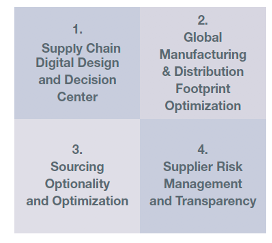Reducing Risk in your Global Supply Chain
Summary
- The economic, geopolitical and environmental risk factors of 2019 are expected to continue in 2020
- While the majority of businesses agree that recession is likely to occur, less than 10% consider themselves well prepared
- There is a major disconnect between the risk factors identified by the WEF's Global Risk Report and the concerns reported by business leaders
- In the face of increased volatility, organizations must be good at continuous improvement, transformation and reinvention
The complex, hyperconnected nature of global supply chains makes them extremely vulnerable to a range of risk factors. In 2019, despite global headline growth, corporations experienced new levels of volatility in commodity and energy pricing, in interest and exchange rates and in general international trading conditions. In 2020 things are likely to remain rocky, with the following factors set to disrupt supply chains:
- Ongoing trade tensions between the United States and its major trading partners
- Growing levels of nationalism and protectionism that restrict trade
- Uncertainty surrounding Brexit and its wider impact on the European Union
- Increasing supply chain risks and costs due to climate-related events and legislative demands
- Volatility in the energy markets
- Potential market corrections driven by record debt levels and rising interest rates
- Increased consumer pressure to improve sustainability and visibility across the supply chain
Despite being forewarned about these risks, research shows many businesses are still tending to be reactive rather than proactive in their approach. A study by leadership and search firm, Russell Reynolds titled, “Preparing for economic uncertainty: Are your operations teams ready?“ found that the 534 companies were in near-unanimous agreement that a recession is likely to occur yet only 8% of them reported feeling as though they personally were well prepared to navigate such a downturn. Similarly, while all of the top five concerns in The World Economic Forum's (WEF) Global Risk Report are related to climate change, it did not make the top ten in a survey of business leaders.

The next stage in supply chain evolution
As the rate of disruption increases across all sectors of all industries, it is imperative that businesses adapt quickly to optimize their manufacturing and distribution footprint and ensure each value-added activity is provided by suppliers that are effectively managing inherent risk of the product/service as well as the geographical location. In the face of increased volatility, organizations must be good at continuous improvement, transformation and reinvention. Far from protecting businesses, risk adversity actually presents a major threat. Businesses that ignore the disruptors and continue doing what they have always done in the way they have always done it, will undoubtedly experience margin erosion and loss of competitive advantage.
A documented end-to-end Supply Chain Risk Management program is critical to growth, profitability and corporate survival. Optimizing your supply chain from a risk, cost, cash, quality and growth perspective will help secure supplier relationships, prevent supply bottlenecks and ensure your company is operating both legally and ethically. Taking a Total Value Optimization approach to risk management and integrated supply chain optimization helps business leaders increase visibility and implement accelerated measurable improvements across the global supply chain. It enables executives to quantify EBITDA improvements, together with operational and working capital risks and opportunities, then develop a documented implementation road map for improvement.
Reducing risk while optimizing supply chains and operations - four domains of value

- Supply chain digital design and decision center - Implementing a supply chain digital design and decision center enables you to balance risk trade-offs with the ability to model, optimize and simulate supply chain network operations. In a digitally enabled supply chain, it is possible to use real-time data to find the best transportation routes and inventory levels for the current state and proactively prepare for potential supply chain events. Contingency planning is made easier with the capability to run scenarios associated with disruptive events and react quickly to new variables.
- Global manufacturing and distribution footprint optimization - In a volatile business environment, it is critical that organizations scrutinize their global manufacturing footprint to ensure each value-added activity takes place in an appropriate low-risk geographical location to achieve the greatest possible competitive advantage.
- Sourcing optionality and optimization - Building in a higher level of optionality and de-risking is the first order of business as companies react to geopolitical events and prepare for a likely economic downturn.
- Supplier risk management and transparency - Implementing an end-to-end approved supplier process and pre-qualification program to protect brand(s), reduce costs, minimize risk, increase visibility and drive improved supplier performance is critical in today's uncertain world.
Uncertainty is here to stay with risk factors likely to intensify in the coming year. A well-documented end-to-end supply chain risk strategy is critical to growth, profitability, peace of mind and corporate survival. If you don't have a documented supply chain continuity and disaster recovery plan, you need to develop one fast. If you have one, you need to test it now.
If you would like to discuss any of the issues raised in this article, contact us for a no-obligation chat. Email info@mainepointe.com
About Maine Pointe
Maine Pointe, a member of the SGS Group, is a global supply chain and operations consulting firm trusted by many chief executives and private equity firms to drive compelling economic returns for their companies. We achieve this by delivering accelerated, sustainable improvements in EBITDA, cash and growth across their procurement, logistics, operations and data analytics. Our hands-on implementation experts work with executives and their teams to rapidly break through functional silos and transform the buy-make-move-fulfill digital supply chain to deliver the greatest value to customers and stakeholders at the lowest cost to business. We call this Total Value Optimization (TVO)™.
Maine Pointe's engagements are results-driven and deliver between 4:1-8:1 ROI. We are so confident in our work and our processes that we provide a unique 100% guarantee of engagement fees based on annualized savings. www.mainepointe.com
